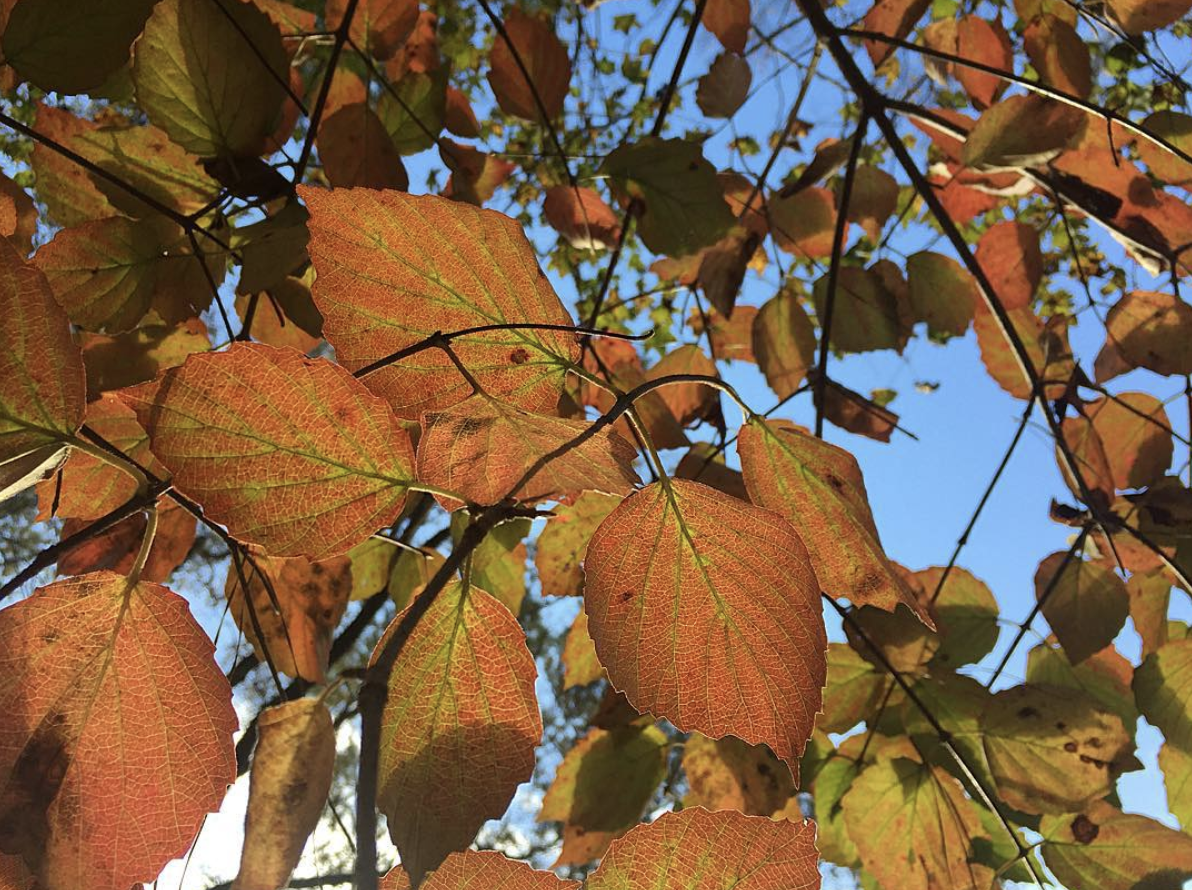Arrowwood viburnum displays a kaleidoscope of colors in e the fall that range from yellow to shades of red and purple.
Native viburnums are a beautiful and diverse group of plants with some of the most unusual and varied autumn coloration. They bloom in spring with a display of white flowers that offer plentiful support to early season pollinators.
The prolific flowering gives rise to a multitude of berries that are loaded with valuable fats for fall migrating birds. Eastern bluebirds, cardinals, brown thrashers, northern flickers, robins, vireos, grosbeaks and cedar waxwings are just a few of the birds that will visit our local viburnum species.
There are a handful of viburnums native to Florida, varying in size, growth habit, evergreen vs. deciduous, soil preference, and bloom times. All are prized in the landscape for their year-round beauty, wildlife value, and versatility. Whatever vision you have, there is a native viburnum species to suit it.
Here are a few noteworthy examples:
Walter’s viburnum, known botanically as Viburnum obovatum, hails from the Southeastern coastal plain, commonly found growing in thickets in moist settings. It is an evergreen shrub with a dense, rounded form, eventually developing into a small tree. Walter’s viburnum will spread by underground runners, so consider mowing around the plant as a preventative.
It blooms in early February, about the same time as redbuds, with slightly fragrant white flowers. If the flowers are pollinated, they will form berry clusters by late summer that shift from red to black when fully ripe. It generally requires moist soils, although it is tolerant of short periods of drought once established. The most important time to water is the first six to 12 months after planting to encourage deep roots.
Walter’s viburnum makes an excellent specimen for the bird garden, offering abundant fall fruit and dense foliage for nesting and cover. Plant as a hedgerow or mix with elderberry, American beautyberry, palmettos, or yaupon holly for a naturalized bird-friendly border.
Selected cultivars of V. obovatum have been bred to remain dense, small shrubs. ‘Mrs. Schiller’s Delight’ grows up to four feet tall and makes a nice formal boxwood substitute. ‘Best Densa’ can grow up to five or six feet tall creating a compact screen or hedge. Plant in light shade or full sun, although if you want profuse long-lasting blooms, full sun with moist soil is best.
Rusty Blackhaw, Viburnum rufidulum, is a small deciduous tree that is much more attractive than its namesake. It has lustrous, glossy leaves that reveal bronze-burgundy fall color and the buds are covered with rusty brown fuzz. With enough sun, they will produce clusters of white flowers in spring followed by berry-like fruits that ripen in October.
The fruit is green as it emerges, turning to red and then blue-black later in the season. Said to taste like raisins, the berries are edible and can be eaten raw, cooked, or made into jelly, though the birds and small mammals usually get to them first.
With enough sun, rusty blackhaw will produce clusters of white flowers in spring, `followed by berry-like fruits that ripen in October and turn to red and then blue-black later in the season
Rusty Blackhaws can be planted in full sun to light shade, however they develop their most attractive form when planted in sun. It tolerates a wide variety of soils as long as the site is well drained. The tree may sucker from the roots, however, mowing around them will prevent those underground runners. Plant as an understory specimen tree or use in a mixed border with dogwood, serviceberry, flowering plums, redbud, red buckeye, or fringe tree.
Arrowwood viburnum, Viburnum dentatum, is a deciduous shrub found in the coastal plain and Piedmont regions. Its long, straight stems were once used by Native Americans to make arrows, hence the common name. This species is highly adaptable to a variety of soil types in full sun to partial shade, so long as the soil doesn’t get too dry.
Glossy green leaves unveil a kaleidoscope of colors in fall that range from drab yellow to shades of red and purple. Its white flowers are not fragrant but appear in dainty flat tops through May and June. This shrub typically reaches 10 to 15 feet in height, with erect stems that arch outwards creating an overall loosely round habit.
Arrowwood produces many highly nutritious metallic blue berries that are essential in providing fuel for resident and migratory songbirds.
Arrowwood has all the wildlife power of the above two species and more. It is a larval host plant for several moth species and a berry-producing machine. Juicy caterpillars are a preferred meal for nesting birds with hungry chicks and the metallic blue, berry-like drupes are essential in providing fuel for resident and migratory songbirds.
In fact, scientists have recently found that arrowwood fruits contain noticeably higher fat and carbohydrate concentrations when compared to other high-yielding berry plants.
Whether it’s for you or your feathered friends, you can’t go wrong with choosing a native viburnum. The more native shrubs we plant in our landscapes, the more food we’ll be providing for the birds we love to watch so much, in the form of berries and insects.
The yards with an abundance of berries will host an abundance of birds and aid in promoting a healthy ecosystem. Next time you are considering a new shrub or small tree for your landscape, I hope you give native viburnums a closer look.


